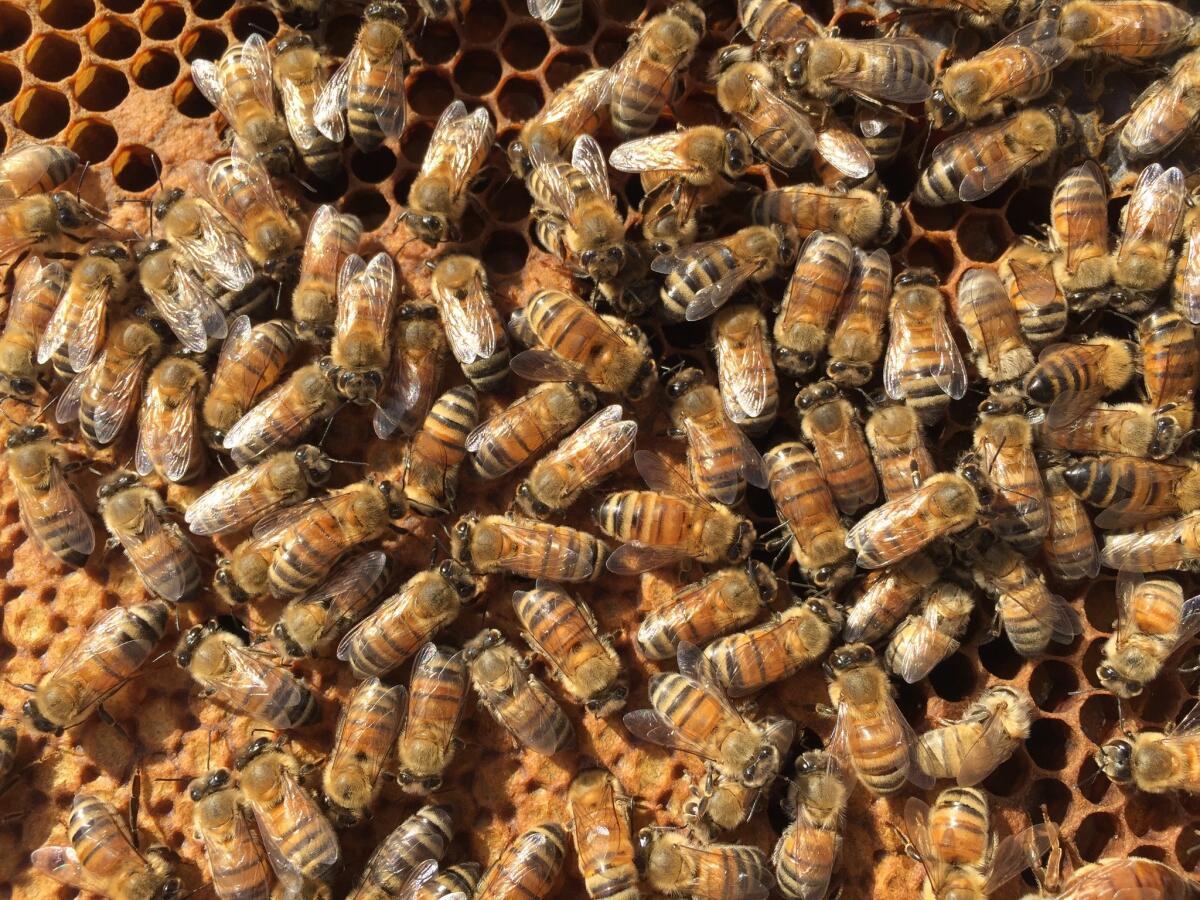6 easy ways you can help save the bees
- Share via
Busy as a bee is an accurate statement.
According to the Xerces Society, a nonprofit organization working to protect bees, 75% of the world’s food crop depends on at least one pollinator, such as the honeybee. (California’s pollinator-dependent crop value is about $12 billion a year.)
That’s a lot riding on the journey of the humble bee and its pollinator friends.
Although bee populations have been pummeled by their share of difficulties in the last few years including habitat loss and the over-use of pesticides, there is something simple you can do to help: plant bee-friendly plants, says Janet Andrews of Backyard Bees, an Orange County-based group that rescues, relocates and maintains feral honeybees in Southern California.
“It’s truly as simple as that and fun,” she says. “We can easily all do our share.”
Here are 6 ways to provide a more bee-friendly flora in your own yard:
1) DON’T USE PESTICIDES
Don’t use synthetic pesticides, insecticides and herbicides. They’re known as harmful to bees and can reduce foraging, navigating abilities, fecundity, reproductive success and impair development, as well as being potentially lethal, says Jessa Kay Cruz, senior pollinator conservation specialist for the Xerces Society.
“Limit [them] not just for bees but for all insects in your yard,” advises Lisa Gonzalez of the entomology department at the Natural History Museum of Los Angeles County. “The vast majority of insects are beneficial or at the least benign; very few are truly problematic pests.” Native plants are already much less likely to have infestation issues and if they do, she says, let natural predators and parasites do their job.
She also suggests purchasing plants not treated with neonicotinoid pesticides, which Harvard researchers have linked to colony collapse disorder in honeybees. Ask where you purchase plants or consider the website of the environmental nonprofit organization Beyond Pesticides.
2) PICK THE RIGHT PLANTS

Lean toward single petal vs. multi-petal plants because a single petal flower’s pollen and nectar are more accessible to bees. It’s also best to use non-hybrid plants because breeding for fancy blooms reduces much of their pollen, says Cruz.
Some natives to try, according to the California Native Society: desert mallow, any salvia (Salvia chamaedryoides is excellent), bush sunflowers, phacelias (above), flowering cactus, desert willow, sunflowers, lavender, wild lilac, woolly blue curls, sneezeweed, coffeeberry, sticky monkeyflower, California poppy, yarrow, California buckwheat and California buckeye are just a few.
3) ‘THINK LIKE A BEE’

Attract bees by “thinking like a bee,” says Jaime Pawelek, a bee garden designer and researcher at UC Berkeley’s Urban Bee Lab. Entice them with food, which comes via plants in the form of pollen and nectar. The best plant choices are “native since our native bees evolved with these plants and are pre-programmed to prefer to visit them,” she says.
Plant in swathes and drifts rather than just one or two plants, say experts, so at least 3 feet of single species is best, according to Pawelek; and keep bee-friendly plants in a single area and not scattered throughout the yard. “When bees go out foraging, they like to visit the same plant over and over in order to get the rewards they’re seeking. So if you put all those plants together in one big patch, they don’t spend that much time searching,” explains Pawelek.
Make sure and plan for successive blooms season-round; honey bees forage all year and most native bees do, too, except in mid-winter.
4) COLOR MATTERS
Bees have excellent color vision (they see a similar breadth of the color spectrum as humans) but it’s shifted toward ultraviolet. “This means they find it really hard to see red; to them it is in the same wavelength as green – imagine trying to find flowers among foliage if they are all the same color,” says Cruz. Yellow, white, violet, purple, blue are all good flower colors, “though bees love Salvia ‘Hot Lips’ (red flowers) as well,” adds Pawelek.
5) LET THEM MOVE IN
Honeybees live in colonies and hives, but 70% of all bee species nest underground, while others use natural cavities to make their nests, says Gonzalez. So leave patches of bare or partially bare, undisturbed, un-tilled soil without mulch to help underground bee nesters.
For wood-and-stem-nesting bees, “this means leaving piles of branches, bamboo sections, hollow reeds, or nesting blocks made out of untreated wood,” says Guillermo Fernandez, director of the Honeybee Conservancy, a bee advocacy nonprofit. Steer clear of composite materials such as hardboard, chipboard or particleboard as they’ll disintegrate in rain. “Or just drill different sized holes in a block of redwood,” says Pawelek.
MORE: How to build a bug hotel
6) PROVIDE WATER

Some bees – mainly honey bees -- need water to drink (most native bees get enough water from the nectar they drink), so creating a water source is a good way to help bees remain longer in your yard. Mason bees also use water to mix with dirt to create mud for their nests.
Place the water source close to your bee-friendly plants by putting out a shallow bird bath with rocks for the bees to land on, or a shallow dish with some pebbles, marbles, sea glass or cork tops. “You’ll often see other wildlife enjoying the water,” says Fernandez. “Just make sure to change the water out often, preferably daily. You don’t want mosquito issues.”






